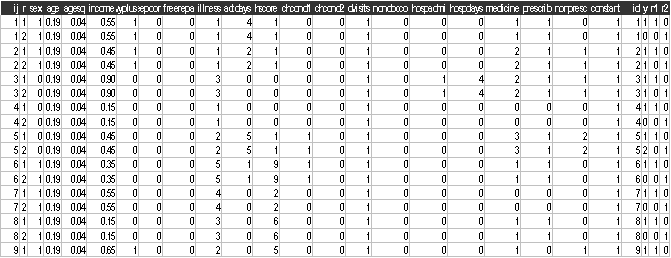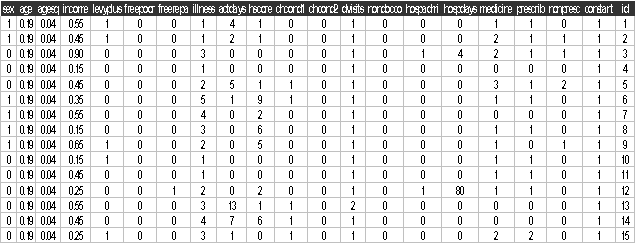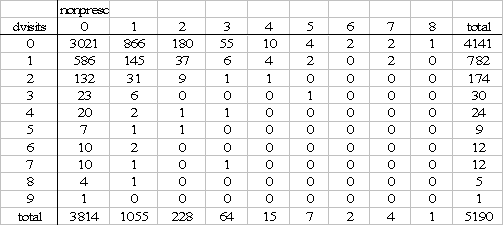Exercise C6, bivariate Poisson models
Cameron and Trivedi (1988) use various forms of overdispersed Poisson model to study the relationship between type of health insurance and various responses which measure the demand for health care, e.g. number of consultations with a doctor or specialist. The data set they use in this analysis is from the Australian Health survey for 1977-1978. In a later work Cameron and Trivedi (1998) estimate a bivariate Poisson model. for two of the measures for the demand for health care. We use a version of the Cameron and Trivedi (1988) data set (called visit-nonprescribe.dat) for the bivariate model. The data for the bivariate model (visit-nonpresc.dat) are a stacked version of Cameron and Trivedi data set. A copy of the original data set (racd.dat) and further details about the variables in racd.dat can be obtained from http://cameron.econ.ucdavis.edu/racd/racddata.html.
Data description
Number of observations (rows): 10380
Number of variables (columns): 26
Variables:
ij = respondent identifier
r = if this is the 1st measure of the demand for health care, 2 for the second.
sex= 1 if respondent is female, 0 if male
age = respondentís age in years divided by 100,
agesq = age squared
income =† respondentís annual income in Australian dollars divided by 1000
levyplus =1 if respondent is covered by private health insurance fund for private patient in public hospital (with doctor of choice), 0 otherwise
freepoor =1 if respondent is covered by government because low income, recent immigrant, unemployed, 0 otherwise
freerepa=1 if respondent is covered free by government because of old-age or disability pension, or because invalid veteran or family of deceased veteran, 0 otherwise
illness = number of illnesses in past 2 weeks with 5 or more coded as 5
actdays = number of days of reduced activity in past two weeks due to illness or injury
hscore = respondentís general health questionnaire score using Goldberg's method, high score indicates bad health.
chcond1 = 1 if respondent has chronic condition(s) but not limited in activity, 0 otherwise
chcond2 = 1 if respondent has chronic condition(s) and limited in activity, 0 otherwise
dvisits = number of consultations with a doctor or specialist in the past 2 weeks†
nondocco = number of consultations with non-doctor health professionals, (chemist, optician, physiotherapist, social worker, district community nurse, chiropodist or chiropractor in the past 2 weeks
hospadmi = number of admissions to a hospital, psychiatric hospital, nursing or convalescent home in the past 12 months (up to 5 or more admissions which is coded as 5)
hospdays = number of nights in a hospital, etc. during most recent admission, in past 12 months
medicine = total number of prescribed and nonprescribed medications used in past 2 days
prescribe = total number of prescribed medications used in past 2 days
nonprescribe = total number of nonprescribed medications used in past 2 days
constant = 1 for all observations
id= ij
y = when r1=1, y is dvisits and when r2=1, y is nonprescribe
r1 = 1 if r=1, 0 otherwise
r2 = 1 if r=2, 0 otherwise
The first few lines of the stacked data (visit-nonpresc.dat) look like:

Suggested exercise:
Univariate models
We will start by estimating separate random effect models on the dvisits and nonprecribe responses in the unstacked data set (racd.dat). The first few lines of racd.dat look like

Start Sabre and specify transcript file:
out nonpresc.log
data sex age agesq
income levyplus freepoor freerepa illness actdays &
†††† hscore chcond1 chcond2 dvisits nondocco hospadmi hospdays medicine &
†††† prescrib nonpresc
constant id
read racd.dat
(1) Fit a random effect Poisson model to dvisits. use a log link and the following explanatory variables† lfit sex age agesq income levyplus freepoor freerepa illness actdays hscore chcond1 chcond2 cons. What do you find?
(2) Fit a random effect Poisson model to nonprescribe, use a log link and the following explanatory variables† lfit sex age agesq income levyplus freepoor freerepa illness actdays hscore chcond1 chcond2 cons. What do you find?
Bivariate Models
We cross tabulate dvisits by nonprescribe in the following table.

Is the assumption of independence between dvisits and nonprescribe realistic?
To estimate the bivariate poisson model you will need to read the stacked version of the data (visits-nonpresc.dat) into Sabre.
out visit-nonpresc.log
data ij
r sex age agesq income levyplus
freepoor freerepa illness actdays &
†††† hscore chcond1 chcond2 dvisits nondocco hospadmi hospdays medicine &
†††† prescrib nonpresc
constant id y r1 r2
read visit-nonpresc.dat
(3) Estimate a bivariate Poisson model for dvisits and nonprecribe using the same explanatory variables for each response in parts 1 and 2. What is the magnitude and significance of the correlation between the random effects of each response? How many quadrature points for each response should we use to estimate this model? Interpret your results?
(4) What do you think are the main problems of applying the bivariate model in this context?
References
Cameron, A.C., Trivedi, P.K., Milne, F., Piggott, J., (1988) A microeconometric model of the demand for Health Care and Health Insurance in Australia, Review of Economic Studies, 55, 85-106.
Cameron, A.C., Trivedi, P.K
(1998), Regression Analysis of Count Data, Econometric Society Monograph
No.30,